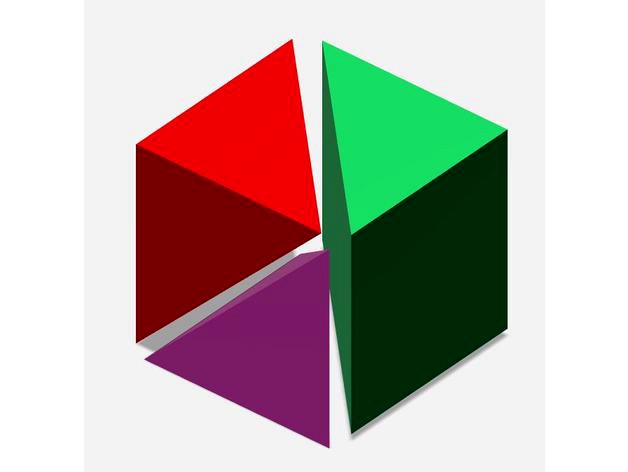Thingiverse

Liu Hui Cube Puzzle/Dissection (Qiandu, Yangma, Bie'nao) by lgbu
by Thingiverse
Last crawled date: 4 years, 4 months ago
The cube can be dissected in multiple ways. There is one well-known dissection that decomposes a cube (or any rectangular prism) into its half, third, and sixth, using two simple face diagonal cuts. The idea dates back all the way to around 263 AD when a famous Chinese mathematician, Liu Hui, illustrated the idea in his commentaries on the Chinese Nine Chapters of Mathematical Arts.
Liu Hui’s dissection can be easily accomplished in a modern 3D design environment such as Autodesk Fusion 360® or similar packages. Take a cube. Slice it along a face diagonal. We get two halves. Each half is called a “Qian Du,” using its original Chinese name. Keep a half piece and slice the other along another face diagonal. We get a square pyramid, which is one third of the cube and is called a “Yang Ma.” The third solid is a tetrahedron, which is one sixth of the cube and is called a “Bie Nao.” It makes natural sense that two halves (Qian Du) make a cube and three Yang Ma make a cube. The Bie Nao are a bit unique. If we take two Bie Nao and make a mirror image of one of them. The two Bie Nao would make a Yang Ma. Therefore, if we take six Bie Nao and mirror three of them, we could make three Yang Ma and further a whole cube. It is fun to explore the visual, spatial, and quantitative relationships among these pieces.
For printing, 0.2 mm is just fine. If you choose 0% infill, you could leave some small magnets inside, when the pieces are half way in the printing process. Please increase shell to 4 if the walls are too thin.
For more information, please refer to
Bu, L. (2017). Exploring Liu Hui’s Cube Puzzle: From Paper Folding to 3-D Design. MAA Convergence. Accessible at https://www.maa.org/press/periodicals/convergence/exploring-liu-hui-s-cube-puzzle-from-paper-folding-to-3-d-design
Liu Hui’s dissection can be easily accomplished in a modern 3D design environment such as Autodesk Fusion 360® or similar packages. Take a cube. Slice it along a face diagonal. We get two halves. Each half is called a “Qian Du,” using its original Chinese name. Keep a half piece and slice the other along another face diagonal. We get a square pyramid, which is one third of the cube and is called a “Yang Ma.” The third solid is a tetrahedron, which is one sixth of the cube and is called a “Bie Nao.” It makes natural sense that two halves (Qian Du) make a cube and three Yang Ma make a cube. The Bie Nao are a bit unique. If we take two Bie Nao and make a mirror image of one of them. The two Bie Nao would make a Yang Ma. Therefore, if we take six Bie Nao and mirror three of them, we could make three Yang Ma and further a whole cube. It is fun to explore the visual, spatial, and quantitative relationships among these pieces.
For printing, 0.2 mm is just fine. If you choose 0% infill, you could leave some small magnets inside, when the pieces are half way in the printing process. Please increase shell to 4 if the walls are too thin.
For more information, please refer to
Bu, L. (2017). Exploring Liu Hui’s Cube Puzzle: From Paper Folding to 3-D Design. MAA Convergence. Accessible at https://www.maa.org/press/periodicals/convergence/exploring-liu-hui-s-cube-puzzle-from-paper-folding-to-3-d-design
